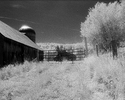B&W processing temps (20 celsius) of C-41 using the normal C-41 results in utter disappointment imho. dMax - dMin is terrible usually and is very difficult to separate tones, making high grain + noise whatever your process plus crap colour. If you want useable (other than 'lomo') results from room temp processing, alternative processing is required.
30 celsius provides satisfactory results, in that you can get a colour image of good definition and fidelity (as opposed to 20c), but colour can be off by differing amounts from the highlight to shadow tonal scale instead of off by a consistent amount across that scale, and can be quite annoying to correct (highlights vs shadows may require different correction vs normal process which a single colour balance is excellent).
I have not had a single problem with C-41 @ proper temp @ 3m 15s on any film using the following method (never had streaking, etc):
Pre-Soak/Rinse (also gets tank+film up to temp) 40-42 celsius
C-41
Stop or Bleach or Blix
Normal from here.
Water stop/rinse after C-41 dev has caused problems for me after moving states and using a totally new water supply - in my case, high base fogging somehow. Until I started using stop or straight to bleach, then everything was dandy.







